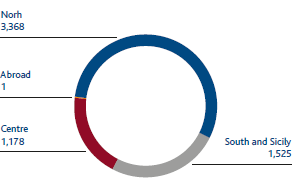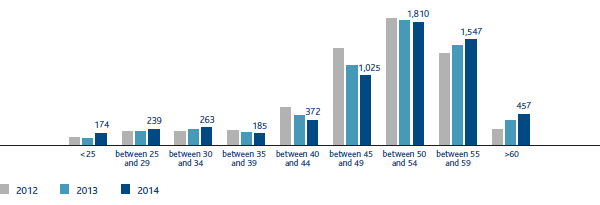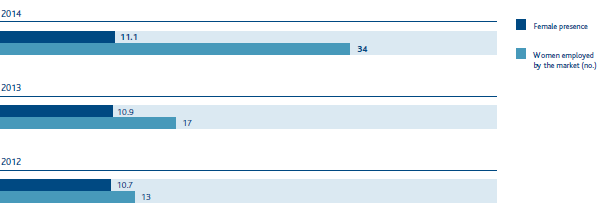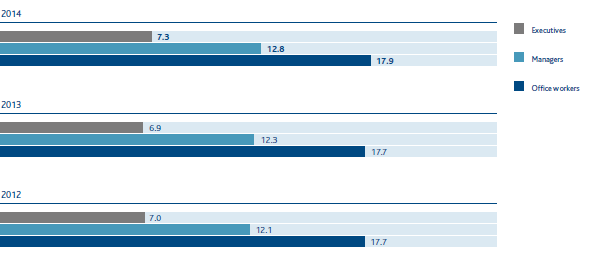People and organisation
2014 was characterised by both a major initiative to change the employment mix, and by the development and consolidation of systems and policies for leadership and performance orientation.
Under an agreement signed with the union organisations, at least 250 young people will be hired during the two-year period 2014-2015, compared with the departure in 2014, due to ordinary mobility or facilitated redundancy, of more than 5% of the workforce. One of the effects of this will be an important contribution to the containment of personnel costs. The initiative, which began in 2014, will continue to produce its effects over the coming years.
Hiring new young people not only tackles the progressive ageing of the workforce, but also refreshes the pool of skills, talent and motivation, which are decisive factors in the international scenario in which Snam competes.
Managerial action within Snam is based on the assignment of precise objectives to each position of responsibility and on transparent assessment of the results achieved, thus allowing constant improvement of the effectiveness and efficiency of organisational processes. On this basis, a new model for the development of professional and managerial skills has been defined. Integrated with the new performance assessment system, this makes it possible to accelerate the individual development paths of staff members with reference to tomorrow’s leadership, which has a strategic value for the development outlook of the business.
A major drive for the simplification and standardisation of organisational processes: the adoption of the Corporate System Framework in 2013 helped to rationalise business processes, procedures and systems.
The strong sense of belonging to the group, which has been highlighted by internal climate surveys, is an asset on which to build active and constructive participation in the processes of change, constantly improving communication and information-sharing.
Thus, a new compact takes shape between the business and its personnel: Snam undertakes to provide new opportunities for growth to those who offer their talent and skills, while its personnel undertake to treat change as an opportunity to acquire new skills and promote their own professional development. This is a cultural paradigm that will make Snam an ever more dynamic, open and competitive business.
Employment
At 31 December 2014, the Snam Group employed 6,072 people. The analysis by contractual category and company included in the scope of consolidation is shown in the following tables:
| Download XLS (22 kB) |
|
PERSONNEL BY COMPANY |
||||
|
|
|
|
|
|
|
(number) |
2012 |
2013 |
2014 |
Change |
|
Snam S.p.A |
672 |
703 |
705 |
2 |
|
Gasrule Insurance Ltd |
|
|
1 |
1 |
|
Snam Rete Gas S.p.A |
1,978 |
1,952 |
1,874 |
(78) |
|
GNL Italia S.p.A |
78 |
79 |
77 |
(2) |
|
Italgas S.p.A |
2,551 |
2,559 |
2,480 |
(79) |
|
Napoletanagas S.p.A |
465 |
449 |
443 |
(6) |
|
Azienda Energia e Servizi Torino S.p.A. |
|
|
201 |
201 |
|
Stogit S.p.A |
307 |
303 |
291 |
(12) |
|
|
6,051 |
6,045 |
6,072 |
27 |
| Download XLS (22 kB) |
|
PERSONNEL BY STATUS |
||||
|
|
|
|
|
|
|
(number) |
2012 |
2013 |
2014 |
Change |
|
Executives |
115 |
116 |
124 |
8 |
|
Managers |
560 |
579 |
602 |
23 |
|
Office workers |
3,257 |
3,271 |
3,280 |
9 |
|
Manual workers |
2,119 |
2,079 |
2,066 |
(13) |
|
|
6,051 |
6,045 |
6,072 |
27 |
More specifically, the employment figures recorded during 2014 were as follows:
- an increase of 398 people, of whom 185 were recruited from the market (40% university graduates and 60% with technical college diplomas) and 213 from Italgas and subsidiaries, due to the consolidation of A.E.S. (203) and new concessions acquired (10 people);
- a reduction of 100 people, of whom 75 due to termination of employment and 25 for other departures from service.
Approximately 96% of Snam personnel have permanent employment contracts. The remaining 4% have apprenticeship contracts that, by law, are temporary (although historically, nearly all apprenticeship contracts have become permanent contracts at expiration, demonstrating the stability that Snam offers by providing lasting employment).
With respect to the group’s distribution country-wide, 3,368 people are employed in the northern regions of Italy, 1,178 in the central regions and 1,525 in the south.
EMPLOYEES BY GEOGRAPHICAL AREA (NO.)
STATISTICAL DIVERSITY: EMPLOYEES BY AGE BRACKET (NO.)
Some 12.6% of the total staff are university graduates, while 52.4% have diploma qualifications; the average age of the people employed by the group fell compared with previous years, from just over 49 to below 48, while the average length of service was around 24 years, stable compared with the previous year.
It is also worth making a separate analysis of the proportion of women within the group.
Despite the typical characteristics of the business activity, which requires a particular technical training taken predominantly by men in the market, the proportion of women is increasing. Women accounted for approximately 20% of total hirings in 2014.
In the business as a whole, women account for around 11.1% of the entire workforce, and this figure has been rising steadily over the last three years. In 2014, with respect to the reference population for each category: 7.3% of executives and 12.8% of managers were women.
To this must be added the evident increase projected for the female population. Analyses carried out on the business population involved in the Leadership Development program show that the presence of women in top management positions is set to increase. The current ratio of women to men is 13%, but this figure will rise to 33.3% among the managers who take part in the programme and to 38.8% among the High Flyer participants.
To this analysis must be added the appointment in July 2014 of 4 new executives of the group, 50% of whom are women.
FEMALE PRESENCE (%)
FEMALE PRESENCE BY STATUS (%)
Organisation
The principal organisational changes that occurred in 2014 can be summarised as follows:
- continuing along the path of strategic development of the Snam Group as a European infrastructure operator, the Corporate departments were reorganised, with the creation in each department of a unit to coordinate their respective international activities. The first two departments to adapt to the new model were Planning, Administration, Finance and Control and Legal and Corporate Affairs and Compliance. The Foreign PAFC Planning, Control and Coordination unit and the Foreign Legal, Corporate and Compliance Coordination unit were established respectively within these departments, reporting directly to the Director;
- in the Planning, Administration, Finance and Control Department, all Administration and Accounting activities – including those linked to the Corporate Reporting Internal Control System – were incorporated into a single department reporting to the Director, and the Accounting Standards Centre was created, with the main task of issuing interpretative guidelines in relation to the new legislative provisions for all departments involved in administration and accounting, at corporate level and for subsidiaries;
- in the Legal and Corporate Affairs and Compliance Department, the Extraordinary Operations Italy Legal and Finance unit was created, with the aim of strengthening oversight in the Distribution area, and the Distribution Operations Legal Assistance unit was subdivided into two units handling the northern and southern areas respectively. In addition, within the Compliance Legal department, the Internal Control System unit was created to handle all matters relating to criminal law, corporate administrative liability, anti-corruption and the domestic legislative system in general;
- within the HSEQ, Property and Facilities Management department, responsibilities relating to the construction of new buildings were incorporated into the Property Investments and Property Management unit, along with those relating to the maintenance of existing assets, with the aim of streamlining the processes linked between them.
During the year, there was a continuation of the “Convergence” project, which saw the participation of personnel from both Snam and Fluxys, with the aim of assessing the opportunities arising from the strategic alliance between the two companies.
Completing a project begun in 2013, a captive insurance company, Gasrule Ltd, was created in Ireland as a wholly owned subsidiary of Snam, with the aim of ensuring more efficient risk management for the group. The project concerned the design of the Company’s organisational structure and the definition of the related processes, and made it necessary to adapt the insurance management procedures of Snam and the companies of the group.
In the area of transportation activities, the new organisational structure was consolidated by defining and strengthening operating mechanisms for optimising the various processes involved in Operations, Commercial Development and Government Relations. With reference to these functions, the following points are of note:
- the development of the new IT solution for managing the commercial processes of gas Scheduling and Balancing, in line with the new requirements imposed by the constant changes in the regulatory and business scenario;
- in the area of Operations, (i) the operational implementation of the organisational restructuring of technical activities, including through changes to the current manual worker professional roles and the introduction of more advanced technological tools for the management of activities relating to gas pipelines and compression and metering stations; (ii) provision of the necessary support for developing overseas transportation activities; and (iii) continuation of the trial that provides for commencement of the working activities of manual workers leaving home without passing through their working bases;
- the review of procurement and logistics processes and the development of new operating models, with reference to the automation of certain activities at the Codogno storage facility and traceability;
- the start of the “ISO 9001 quality certification” project, aimed at extending the related certification to the entire Company, which requires, inter alia, adaptation of the regulatory system of Snam Rete Gas.
In the course of 2014, within the scope of storage activities, organisational changes took place as summarised below:
- in the area of Operations, the organisational and operational model was implemented, relating to the imminent separation of the services hitherto provided by eni Exploration & Production for the static and dynamic modelling of deposits and the drilling and renewal of wells; in particular, to ensure the transition to the new organisational and operational model, internal oversight was strengthened in terms of specialised resources and skills, and scheduled initiatives for the training of personnel and the qualification of new suppliers for the acquisition of the relevant services are close to completion;
- in storage and logistics activities, a centralised management procedure was launched for certain materials management processes, similar to the model already developed by the group, such as the management of materials registers, testing, materials planning, transport and management activities.
In the regasification segment, the organisational and regulatory system was strengthened, with a more in-depth examination, in particular, of the plant operating and maintenance processes, including through the issuance of dedicated operating instructions.
On the other hand, in the scope of distribution, in 2014 the following are of particular note:
- in relation to Italgas and Napoletanagas, work continued on technical and functional analysis and development and production of the technical solution identified for the technological upgrade of the group’s Enterprise Resource Planning (ERP) system (the final go-live is scheduled for January 2016);
- activities aimed at the progressive standardisation of processes and organisational structures also continued. In relation to Italgas, the Gas Distribution Rome unit assumed an organisational structure consistent with that of the Districts, with a consequent adaptation of the IT systems supporting the processes concerned. In relation to Napoletanagas, the processes involved in storage management, materials transfer management and the delivery of materials to operational teams were brought into line with the group model;
- a project was launched with the aim of progressively bringing the processes and systems of A.E.S. into line with the model and services of Italgas;
- the merger by incorporation into Italgas of Metano Arcore and the integration of the Municipality of Paderno Dugnano following the tender award made it necessary to implement a project to update the operational and organisational procedures for the management of gas distribution activities and the integration of resources and assets within Italgas, with a consequent upgrading of the IT systems;
- with reference to Napoletanagas, the OONN Sector Accreditation Committee of Accredia resolved, on 27 October 2014, to accredit the Company for the periodic inspection of volume conversion devices associated with gas meters (Type 1) in accordance with the provisions of Ministerial Decree 75/2012, and accordingly provided for the creation of the Inspection Body organisational unit and the definition of procedures for the management of these activities.
With reference to the group Regulatory System, there was a continuation of the review project begun with the publication in 2013 of the Corporate System Framework. In this context, the Management System Guidelines issued by eni and adopted by Snam were all repealed, and their content was inserted into the group operating procedures and instructions. Work also began during the year on the project to overhaul the documentation system that contains the group regulations, with the aim of making it easier and quicker to consult documents.
Involvement and participation initiatives
Snam believes that communication plays a key role in promoting the participation and involvement of its staff in growth and in the development of their respective business activities.
Communication directed at group personnel is not just a transmission medium, but should also be an “agent of change” affecting values, suggesting new viewpoints, contributing to change in the corporate culture and stimulating new forms of behaviour.
Special attention was paid to the instrument panel used for communicating, with the launch of an organic plan of changes whose main features are as follows: content more appropriate to the needs expressed by staff, a more direct style of communication, more space devoted to staff and life within the company, greater use of video for sharing experiences, initiatives and company events, more space for welfare initiatives, and “listening” with surveys on specific issues.
A few examples of the channels and tools used by Snam to share values, challenges, goals and projects are the company intranet, the “Saperne di+” ("Learn more about it") initiative, the circulation of newsletters, brochures and other paper products, and the now firmly established annual meetings with executive staff: an opportunity to reflect on the most significant moments in the activities of the business in order to ensure adequate information and a constant sense of involvement and responsibility with regard to company strategies and objectives.
In 2014 the intranet portal was the favoured channel for disseminating a new way of communicating: the home page became the space for headline news, highlighted issues, launches of company initiatives and pop-ups; new features were introduced into the portal, such as galleries with videos and photos to provide immediate and graphic information about company experiences and events.
With the aim of creating a “new intranet”, a dedicated working group was set up to respond to the needs expressed by staff and to support change, so that the portal can become the main point of contact with the company and carry its identity. The new portal will be completed and usable during 2015.
Training
Development and consolidation of the system of professional skills, in tune with trends in the environment in which the business operates, are an integral part of the personnel development process.
Training is an essential element for enriching the employment opportunities of personnel and for supporting the processes of organisational integration and change management.
In 2014, more than 174,900 hours of training were provided in total (amounting to 28.8 average hours per employee) to 17,043 participants.
| Download XLS (22 kB) |
|
TRAINING BY POSITION |
||||
|
|
|
|
|
|
|
(hours) |
2012 |
2013 |
2014 |
Change |
|
Executives |
2,366 |
6,133 |
4,974 |
(1,159) |
|
Managers |
15,841 |
23,699 |
14,509 |
(9,190) |
|
Office workers |
65,209 |
117,942 |
73,404 |
(44,538) |
|
Manual workers |
77,355 |
50,584 |
82,029 |
31,445 |
|
|
160,771 |
198,358 |
174,916 |
(23,442) |
The proportion of Company personnel involved in training initiatives was 93.2%, a sure sign of the continual and all-encompassing commitment to update and develop the knowledge of all personnel.
During the course of the year, the Forma(re)ti project, launched in the previous year, was completed. The training programme, shared with Terna, gave a group of executives and managers from the various companies an important opportunity to compare notes on business issues of common interest.
With a view to greater openness to the international context, Snam pursued its commitment to language training courses with the relaunch of the Energienglish Project, which offered all Snam personnel the opportunity to take an online English course provided by EF Corporate Language Learning Solutions. The Company also offers other dedicated courses for those who need advanced language skills.
Snam is at pains to emphasise the strategic value of leadership, a necessity that is becoming increasingly pressing, especially when operating in a European market.
With this in mind, the “Leadership Development Programme” was launched: this is a management development course aimed at accelerating the development paths of around 200 people selected from among executives, managers and younger employees. In support of this project, a structured programme of initiatives was prepared, using a variety of levers including training, individual mentorship provided by executives, compensation and deferred incentive plans for managers.
The “Young Graduates in Engineering” project was also launched. As well as helping to replenish the mix of resources, this aims to prepare young engineers for taking on responsible roles by means of a specific professional and training path. This path involves, for a period of three years, changes of activities, objectives and the type and place of work, as well as a structured training programme in the various areas (financial/business, behavioural and professional).
Initiatives in favour of employees
Snam’s corporate welfare system is a carefully structured group of instruments and services that aims to provide employees with a better work/life balance and, more generally, a better working experience.
The more traditional and established components of the corporate welfare system are as follows: supplementary insurance against workplace and non-work-related accidents, supplementary healthcare assistance covering public and private healthcare and hospital expenses, and supplementary pension funds, which in most cases are topped up by employer contributions.
In addition to these benefits, there are initiatives and services for people in the following major areas: family, health and well-being, time and space, savings and relationships.
With the aim of offering a range of services and initiatives increasingly in line with employees’ expectations, the welfare services study, which began in 2013, was completed. This involved the following measures: an analysis of the Company’s workforce and identification of needs, with an assessment of the services currently provided and the creation of a map of priorities; a refinement of the map with direct involvement and feedback from staff through special focus groups, with the aim of identifying the need for implementation of new services; and an in-depth investigation of the effectiveness and efficiency of the existing services, resulting in a proposal for a new and enlarged “welfare package”.
With regard to “sustainable mobility”, this year saw the first implementation within Snam of the “Home-Work Commuting Plans” at the San Donato/Milan, Turin, Rome and Naples sites, with the aim of identifying and taking action to improve the quality of employees’ commuting journeys.
Industrial relations
The relevant national collective labour agreements (the energy and oil contract for the transportation, storage and regasification segments and the gas/water contract for the distribution segment) apply to all Snam workers.
Snam guarantees all workers the right to express their thoughts freely, to join associations and to engage in trade union activities. At the end of 2014, 49.5% of employees were members of a union.
Union activities can be held in appropriate meeting places, and employees are given special time off in accordance with the provisions of the legislation in force and the applicable sector trade union agreement.
For the issues that concern them, all employees can refer to the Unitary Representation Bodies (RSUs), which are periodically renewed through elections.
During 2014, 130 meetings were held with the trade union organisations; a high number of meetings, at both national and local level, is a feature of the relationship between Snam and these organisations.
The negotiations paved the way for the use of a participatory model across all levels, as agreed in the new Industrial Relations Protocol signed by the parties on 17 October 2013. This agreement represents the reference instrument for strengthening a relationship model capable of allowing the development of further tools for promoting a participatory culture among employees.
In accordance with the rationale behind the industrial relations aimed at strengthening Level Two negotiations, the Parties agreed on the 2014-2016 performance-related pay structure for all group companies. The negotiations, which involved the trade union organisations at all levels, were aimed at establishing the correlation between salary components and competitive business performance, by defining profit-sharing models.
During the course of the year, action was also taken on the basis of the provisions agreed in the Employment Protocol signed in October 2013; in January 2014, for all group companies, the mobility agreement pursuant to Articles 4 and 24 of Law No. 223/91 was signed. In addition, with the aim of enhancing dialogue between the parties, a group mobility Verification and Control Committee was established, consisting of representatives from Snam’s Industrial Relations department, the national secretariats of the trade unions for the energy, oil, gas and water sectors, and the regional RSUs/trade union bodies. Periodic meetings of the Committee were held, throughout the entire duration of the mobility procedure, in order to monitor the implementation of the system and of the agreements reached, with particular reference to the implementation of the employment plan provided for in the above-mentioned Protocol. Specifically, work is currently under way to define the plan for the recruitment of resources in the group’s various operating units, according to the departures that take place under the mobility procedure.



